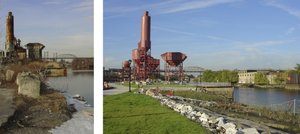Concrete Plant Park Brings the Bronx to its River

On October 30, the New York City Department of Parks and Recreation cut the ribbon on Concrete Plant Park, the product of a collaboration between the Pratt Center and the Bronx River Alliance, a partnership of community and environmental organizations and government agencies, to turn a former industrial site along the Bronx River into a green open space. Parks Commissioner Adrian Benepe set the tone by acknowledging that "the Concrete Plant Park shows what can happen when government is smart enough to listen to the community.” A decade after local groups first pressed to turn the abandoned site of the Edgewater Concrete Plant into a waterfront oasis, the plant’s reddish-brown silos stand as sculptural monuments to the site's past identity and present reuse. The riverbank has attracted fishermen, children hunting blue crabs, and cyclists and skaters seeking a refuge from busy streets.
The seven-acre park, located between the Bruckner Expressway and Westchester Avenue, adds a major link to the Bronx River Greenway, which when complete will provide public access to the river from Long Island Sound up to the Westchester border. An interim plan for the site’s transformation emerged in 2001 from a collaboration between community groups, including Youth Ministries for Peace and Justice, the Point CDC and Sustainable South Bronx, with the Pratt Center's assistance. That early plan enabled local groups to press the city to act. It also spawned a collaborative design process between local participants and the city Parks Department, generating features like a circle of large chairs that provides a setting for workshops and meetings. And a visit to reclaimed industrial sites in Germany's Ruhr Valley organized by the Pratt Center inspired community leaders to retain the silos that are now the park’s signature element.
“This park is the culmination of over a decade of community activism to reclaim the river and have access to the Bronx River waterfront,” said Maggie Scott Greenfield, Greenway Director for the Bronx River Alliance. “Community groups developed a vision of what the park should be, a place where people could get to the river and get away from it all.”
YMPJ Executive Director Alexie Torres-Fleming told the crowd at the ribbon-cutting: “This story is about being able to connect and really being able to honor the things that are really, really important: community voice, community legacy, community stories. I’m very moved by the thought that my children are playing here. They didn’t even exist when this happened.”
Concrete Plant Park lies just east of the Sheridan Expressway, a redundant and underutilized road many of the same groups that helped build the park have been campaigning to demolish. The Pratt Center and its partners in the Southern Bronx River Watershed Alliance have developed a plan for the Sheridan site that includes affordable housing, open space, retail services, light industry and neighborhood amenities. Demolition of the Sheridan would provide direct access to Concrete Plant Park and the Bronx River waterfront.
The new park provides more than a space for relaxation – the greenway could become a safe route to and from school for kids who now have to navigate the narrow sidewalks of the neighborhood’s heavily-traveled truck routes. Even before the park officially opened, the end-of-day bells at the four public schools that line those streets, sent a stream of school children into the park for the journey home. The Pratt Center and the Bronx River Alliance are now pressing the New York City Department of Transportation to move quickly to make the low-cost improvements that will safely link those schools to the new park.